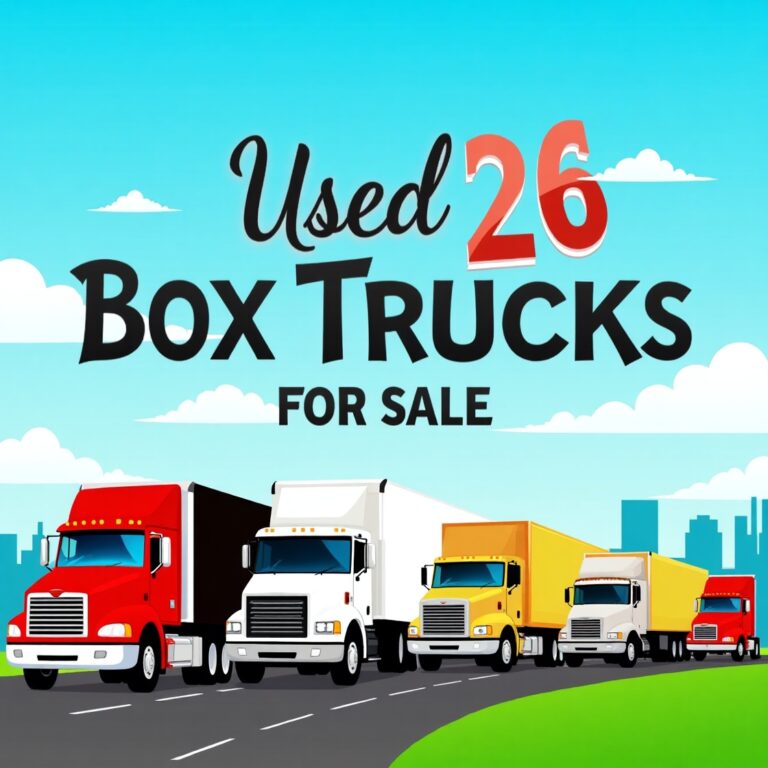The Unprecedented Flood: 15,000 Trucks Hit the Market ‘Near You’ – A Buyer’s Bonanza

The Unprecedented Flood: 15,000 Trucks Hit the Market ‘Near You’ – A Buyer’s Bonanza
Word Count: Approximately 1500 words
Picture this: a horizon stretching not with fields or skyscrapers, but with row upon row, mile after mile, of trucks. Not just a few dozen, or even a few hundred, but an staggering fifteen thousand commercial vehicles, all suddenly available for purchase. While the literal interpretation of "near me" might vary, the reality of such a colossal inventory hitting the market implies a sales event of unprecedented scale, designed to reach every potential buyer, wherever they are. This isn’t just a sale; it’s a seismic shift in the used commercial vehicle market, a phenomenon that demands attention from every fleet manager, owner-operator, small business owner, and even the intrepid individual looking for a robust workhorse.
The sheer volume of 15,000 trucks is difficult to comprehend. To put it into perspective, a typical large commercial truck dealership might have a few hundred units on its lot at any given time. A fleet of 15,000 trucks could easily constitute one of the largest private or government fleets in the world. Its sudden availability isn’t just a market fluctuation; it’s a profound event with far-reaching implications, creating a buyer’s market unlike anything seen in recent memory.
The Unprecedented Scale: What 15,000 Trucks Truly Means
To grasp the magnitude, consider that if these trucks were lined up bumper-to-bumper, assuming an average length of 30 feet per truck (including light, medium, and heavy-duty vehicles), they would stretch for over 85 miles. That’s roughly the distance from Los Angeles to San Bernardino, or London to Cambridge. It’s a number that speaks of massive fleet liquidations, strategic corporate divestitures, or perhaps even a significant government surplus release.
Such an event fundamentally alters the supply-demand dynamics of the used truck market. Prices, traditionally dictated by scarcity and demand, are likely to soften across the board, presenting a golden opportunity for buyers. Furthermore, the sheer variety expected within such a vast inventory means that almost every conceivable commercial need, from last-mile delivery vans to heavy-haul semi-trucks, is likely to be met.
Why Now? Decoding the Phenomenon
The sudden appearance of 15,000 trucks for sale isn’t accidental; it’s the result of significant underlying forces. Several plausible scenarios could trigger such a massive liquidation:
-
Massive Fleet Modernization & Strategic Liquidation: A colossal logistics, construction, or transportation conglomerate might be undertaking a complete overhaul of its fleet. This could involve transitioning to newer, more fuel-efficient models, adopting electric vehicles (EVs), or consolidating operations. Selling off such a large number of assets simultaneously would be a strategic move to finance the new acquisitions and streamline their portfolio.
-
Economic Rebalancing or Downturn: A significant economic contraction could lead multiple large companies to downsize their operations, shedding excess capacity. Conversely, a period of rapid economic growth might have led to over-acquisition, and companies are now right-sizing their fleets.
-
Government or Municipal Surplus: Large government agencies (federal, state, or municipal) frequently rotate their fleets. A major release of surplus vehicles from postal services, defense departments, or utility companies could account for a substantial portion of this inventory. These vehicles are often well-maintained, though sometimes specialized.
-
Industry Consolidation or Bankruptcy: A merger of two large trucking companies, or the bankruptcy of a major player, could result in the rapid liquidation of assets to pay off creditors or integrate redundant fleets.
-
Technological Transition: The push towards autonomous vehicles, alternative fuels (CNG, Hydrogen), or full electrification might be prompting companies to divest their legacy diesel fleets en masse, even if the new technologies aren’t fully deployed yet. This foresightful move could free up capital and infrastructure for future adoption.
Regardless of the precise trigger, the result is a market flush with options, turning the tables firmly in favor of the buyer.
Who Benefits? A Buyer’s Market for Every Need
The beauty of such a massive inventory lies in its ability to cater to an incredibly diverse range of buyers:
- The Budding Entrepreneur & Small Business Owner: For a startup logistics company, a new construction outfit, or a local delivery service, this sale offers an unparalleled chance to acquire reliable vehicles at potentially significant discounts. Lower acquisition costs mean lower overheads and a faster path to profitability.
- Established Fleets Looking to Expand or Upgrade: Larger companies can strategically replace aging units, add capacity for new contracts, or diversify their fleet at a fraction of the cost of new vehicles. This is an opportunity to scale operations without massive capital expenditure.
- Owner-Operators: Individual truckers can upgrade their rigs, purchase a backup vehicle, or even buy a specialized unit they couldn’t previously afford. The competition for quality used trucks usually drives prices up, but this scenario flips that dynamic.
- Specialized Industries: Construction companies, agricultural businesses, waste management services, utility providers, and even event management firms could find highly specific vehicles (dump trucks, flatbeds, reefer units, service trucks, mobile stages) tailored to their unique needs.
- International Buyers: While the "near me" implies a domestic focus, such a large-scale sale would undoubtedly attract international buyers looking to import vehicles, especially if the prices are competitive globally.
- Individuals & Hobbyists: Even those seeking a heavy-duty pickup for personal use, a box truck for moving, or a vocational vehicle for a unique project might find an unexpected gem among the thousands.
The Diverse Inventory: A Truck for Every Task
With 15,000 units, the inventory would be incredibly varied, spanning almost every class and configuration of commercial truck:
- Light-Duty Commercial Vehicles: This category would include cargo vans (Ford Transit, Mercedes-Benz Sprinter, Ram ProMaster), pickup trucks (Ford F-Series Super Duty, Ram Heavy Duty, Chevrolet Silverado HD) in various configurations (single cab, crew cab, flatbed upfits), and cutaway chassis used for box trucks or specialty builds. Ideal for last-mile delivery, small trade businesses, or personal heavy-duty use.
- Medium-Duty Trucks: Encompassing Class 4-6 vehicles, this segment would feature a vast array of box trucks (various lengths, roll-up vs. swing doors, with or without liftgates), stake body trucks, flatbeds, refrigerated trucks (reefers), utility trucks with service bodies, and tow trucks. Brands like Ford F-650/F-750, Freightliner M2, International MV Series, and Hino are common here. Perfect for local and regional hauling, moving companies, and specialized service providers.
- Heavy-Duty Trucks: The workhorses of long-haul transportation, Class 7-8 trucks would include a significant number of semi-trucks (tractors) in various axle configurations (day cabs for regional hauls, sleeper cabs for long-distance). Expect models from Peterbilt, Kenworth, Freightliner, Volvo, Mack, and International. Also present would be heavy-duty vocational trucks like dump trucks, concrete mixers, refuse trucks, and specialized heavy haulers. These are essential for long-haul logistics, heavy construction, and large-scale industrial operations.
- Specialized & Vocational Vehicles: Beyond the common types, a sale of this magnitude would likely include highly specialized vehicles: crane trucks, vacuum trucks, municipal vehicles (salt spreaders, street sweepers), fire trucks, ambulances, and even specialized off-road commercial vehicles. These often come from government surplus or highly specialized fleet liquidations.
The condition of these trucks would vary from "gently used" with low mileage and excellent maintenance records to "work-ready" units requiring some immediate attention, and perhaps even "project vehicles" suitable for parts or extensive restoration. Buyers would need to be prepared for this spectrum.
Navigating the Purchase: A Buyer’s Guide
While the opportunity is immense, purchasing a commercial vehicle, especially in a high-volume sale, requires careful due diligence. The "near me" aspect of such a massive sale would likely be facilitated through a combination of online platforms, regional viewing hubs, and dedicated sales teams.
- Online Portal & Virtual Tours: A centralized online platform would be crucial, allowing buyers to browse the entire inventory, filter by type, make, model, year, mileage, and price. High-quality photos, detailed specifications, service records (where available), and even virtual 360-degree tours or video walkthroughs would be essential.
- Regional Inspection Hubs: Given the scale, the 15,000 trucks would likely be distributed across several large regional lots or staging areas. This allows buyers to physically inspect vehicles that are "near" their location or within a reasonable travel distance.
- Thorough Due Diligence:
- Research: Understand the specific needs of your business. What type of truck, capacity, and features are essential?
- Vehicle History Reports: Obtain VIN reports (e.g., Carfax, Autocheck, or specialized commercial vehicle reports) to check for accident history, title issues, and reported mileage discrepancies.
- Maintenance Records: Request detailed service and maintenance records. A well-maintained truck, even with high mileage, can be a better investment than a low-mileage unit with a spotty history.
- Physical Inspection: If possible, conduct a thorough physical inspection. Check for rust, frame damage, tire wear, fluid leaks, and overall cab condition.
- Mechanical Inspection: This is paramount. If you’re not an experienced mechanic, hire an independent, certified commercial vehicle mechanic to perform a pre-purchase inspection. They can identify potential issues with the engine, transmission, brakes, suspension, and electrical systems.
- Test Drive: Always test drive the truck under conditions similar to its intended use. Pay attention to how it handles, shifts, brakes, and if there are any unusual noises or warning lights.
- Financing & Logistics:
- Pre-Approval: Get pre-approved for financing from your bank or a specialized commercial vehicle lender. The rapid pace of such a sale means you need to be ready to act.
- Insurance: Obtain insurance quotes beforehand. Commercial vehicle insurance can be complex and costly.
- Transportation: Plan how you will transport the truck from the sale location to your base of operations. This might involve driving it yourself, hiring a professional transport service, or coordinating with the seller if delivery options are available.
- Legal & Titling: Ensure all paperwork is correct and complete for transferring ownership and registering the vehicle in your state or country. Understand any applicable sales taxes or fees.
Economic Ripple Effects
The sale of 15,000 trucks isn’t just about individual transactions; it has broader economic implications:
- Boost for Small and Medium Enterprises (SMEs): By lowering the barrier to entry or expansion, more SMEs can acquire the necessary assets to grow, fostering local economies and creating jobs.
- Supply Chain Resilience: A more robust and accessible fleet of trucks can enhance the efficiency and resilience of local and national supply chains.
- Impact on New Truck Sales: While beneficial for the used market, such a large influx could temporarily depress the market for new commercial vehicles, prompting manufacturers to offer more incentives.
- Service and Parts Market: The influx of used trucks will generate increased demand for maintenance services, repairs, and parts, benefiting mechanics, service centers, and auto parts suppliers.
- Employment: More trucks on the road, especially for expanding businesses, translates to increased demand for drivers, dispatchers, and support staff.
The "Near Me" Factor Reimagined
While it’s unlikely 15,000 trucks are physically parked on your street, the "near me" aspect of this sale would be meticulously engineered for buyer accessibility. This would involve:
- Decentralized Inventory, Centralized Information: The trucks would be spread across numerous large lots strategically located near major transportation hubs or population centers across the country/region. The online platform acts as the central nervous system, connecting buyers to inventory regardless of their physical proximity to a specific lot.
- Virtual Accessibility: Advanced digital tools, as mentioned, would allow buyers to experience the trucks almost as if they were there – detailed photos, videos, virtual tours, and comprehensive documentation.
- Nationwide Delivery Options: The selling entity would likely partner with logistics companies to offer competitive delivery rates to any buyer’s location, making the physical distance less of a barrier.
- Dedicated Sales Support: A large sales team, potentially with regional representatives, would be on hand to answer questions, facilitate inspections, and guide buyers through the purchase process, bridging the gap between the vast inventory and individual needs.
Conclusion: A Fleeting Window of Opportunity
The availability of 15,000 trucks for sale ‘near you’ is not just a commercial event; it’s a testament to the dynamic nature of the global economy and an unparalleled opportunity for businesses and individuals alike. It’s a chance to acquire essential assets at potentially advantageous prices, to expand operations, or to embark on new ventures with a solid foundation.
However, opportunities of this magnitude are often fleeting. The sheer volume might seem endless, but demand from a hungry market can quickly deplete even the largest inventories. Those who are prepared, who have done their research, secured their financing, and are ready to act decisively, will be the ones to reap the most significant rewards from this extraordinary commercial vehicle event. Don’t just observe this seismic shift in the market; participate in it, and drive your business forward.




